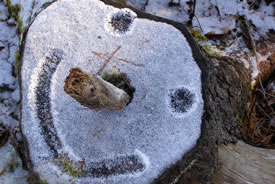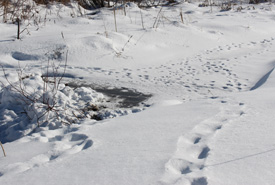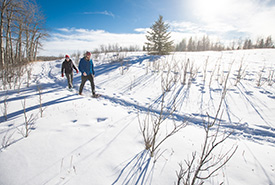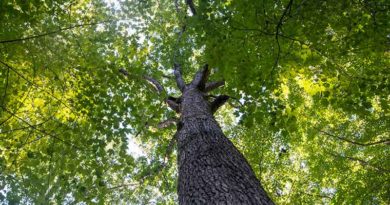NCC: Nature therapy (part five): Motivated by Nature

Winter smile (Photo by Amanda Cashin Photography)
It’s no secret that this year has been, and still is, challenging. During the winter, it is important to think about what we can do to help combat the winter blues. Whether we are working from home and indoors more, and/or suffer from seasonal affective disorder, there are many tools that we can equip ourselves with to help promote mental and physical well-being. One of those tools is nature. Read on to find out why getting outdoors is more important than ever this year and be inspired by activities that you can do to make your own winter memories.
Shake those winter blues with our printable nature activities bucket list.
Please adhere to the provincial and local public health regulations to help ensure your safety and safety of others during this time of COVID-19.

Small mammal tracks in the snow (Photo by NCC)
Susanne Heaton reached out to me after viewing the Nature Conservancy of Canada’s NatureTalks webinar about nature and mental health. It became apparent that we shared many of the same values and goals about nature and well-being, so we kept in touch. Susanne grew up on her parents’ farm in the village of Miami, Manitoba. It was in this setting she was taught so many lessons from nature that at the time, she did not even realize she was learning. In 2009 after suffering from burnout and loss, Susanne was inspired to take a leap of faith and started her own business, Motivated by Nature. She now offers online nature challenges; monthly challenges with daily prompts and tasks to help increase your exploration of and appreciation for nature.
Read my interview with Susanne below:
Kayla Burak (KB): Why do you think it is important for people to be thinking about how they can get outdoors and experience nature during the winter?

A winter hike on the Bunchberry Meadows property (Photo by Brent Calver)
Susanne Heaton (SH): During stressful times like this, getting outdoors can greatly benefit our mental and physical well-being. When we go outdoors, we breathe in phytoncides (organic compounds) emitted by plants and trees. It is a great way to naturally boost our immunity, especially during cold and flu seasons. Also, the biomes in the soil change with each of the seasons. As we go outdoors and breathe these in, they help balance our gut health which has been linked to its effect on our mental health and well-being. Getting outdoors to exercise can be more beneficial for decreasing stress than working out in a gym.
KB: What are some ideas of activities that people can do this winter to support their mental and physical health?
SH: The biggest thing to remember is to have fun with whatever it is you decide to do outdoors. If it is a “have to” instead of a “want to,” you will not keep it up. Another huge tip is to find an accountability buddy to share how often you will get outdoors/week. In my experience, people who share their goals are more likely to achieve them.
Getting outdoors for a half-hour walk while activating your senses helps you become mindful of your surroundings. We tend to just focus on what we see. Layer on what you are feeling, hearing and smelling. We can even use our imagination to “taste” nature. For example, what do you think a cloud might taste like? You can have a discussion with a young person in your life about this — their responses may surprise you!
KB: What would you say to help inspire someone who is struggling to find the time or find ways to start building, or maintaining, a relationship with nature?
SH: There is no doubt it is easier to sit on the couch instead of bundling up to get outdoors, but there are a few things you can do to help this process.
- Talk to a friend or family member about being an accountability partner that can help keep you stay on track.
- Think about getting an accountability partner to check in with you. Even just 10 minutes outside per day is beneficial. The goal is half an hour, but the reality is that
life happens. Be gentle on yourself and do what you can. I operate on the good, better, best principle. Good is just taking a pause indoors and looking out your window at the beauty that is all around you. Better is sitting outdoors and just breathing and relaxing. Best is getting outdoors for a half hour walk, which helps to clear your mind. - Dress for the elements. Dress in layers and try to stay out of the windiest areas. It is much easier to take layers off than to not be properly dressed for the elements.
- Design your own reward system. For example, each day after a walk, you get to enjoy a nice warm cup of tea or some hot cocoa!
- Take your children with you on you walk – you may be surprised at what you see through their eyes.
- Track your mood in a journal. See how you feel before going for a walk, and then after you come in. Seeing how you can shift things in a positive direction after a walk helps to connect you to wanting to feel that same way again.




